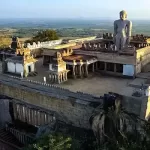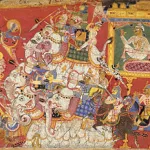Dharmachakra, The cycle of life and death is a recurring pattern. One is born, lives, dies, and is reborn. In Hinduism, the wheel, or chakra, serves as a powerful symbol of this cycle. However, a chakra holds deeper meanings beyond this representation.
As the Kalachakra, the chakra also embodies the concept of time. It signifies how events in the present are echoes of those in the past and precursors to the future. The Yugas, or cosmic ages, function in a continuous cycle. The wheel of time also takes on a fierce form as a weapon, symbolizing Vishnu’s wrathful aspect. This weapon is known as the Sudarshan Chakra.
ALSO READ: Lakkundi and Shravanabelagola’s Monolithic Marvels
In Buddhism, the wheel has its own profound significance. The Wheel of the Law, or Dharmachakra, is the most important symbol, representing the Buddha’s First Sermon at Sarnath, where he set forth the teachings of Buddhist Law (dharma).
Chakras, often associated with various ancient meditation practices collectively known as Tantra—encompassing the esoteric or inner traditions of Buddhism and Hinduism—serve as key focal points for spiritual energy.
The wheel also represents the idea that, despite life’s challenges, we should continuously strive for progress and forward movement.
A special thanks to Vani for crafting this beautiful sketch of the Chakra exclusively for “The Heritage Diary.”

Dharmachakra: The Symbolism of the Wheel
In Indian history, spoked-wheel emblems, or chakras, are among the most ancient symbols. According to Madhavan and Parpola, the wheel symbol frequently appears in artifacts from the Indus Valley Civilization, particularly on various seals. Notably, it is also featured on the Dholavira Signboard as part of a sequence of 10 symbols.
Some historians associate ancient chakra symbols with solar imagery. In the Vedas, the solar disk is likened to a one-wheeled chariot (cakra) and is linked to the deity Surya. Mitra, an aspect of Surya, is described as “the eye of the world,” symbolizing the sun as an eye (cakṣu) that observes and illuminates the earth. Similarly, a wheel is a defining attribute of Vishnu. Consequently, the wheel symbol can also represent wisdom and light.
The Dhammacakkappavattana Sutta describes the Buddha’s first discourse as the moment when the “wheel of dharma” was set into motion. This “turning of the wheel” symbolizes the actions of an extraordinary individual bringing about a profound and transformative change with worldwide impact. Buddhism adopted the wheel as a symbol, inspired by the Indian concept of the chakravartin, or “wheel-turner” and “universal monarch.” This ideal king was said to possess several mythical items, including the ratana cakka, the perfect wheel.
In the Maha Sudassana Sutta of the Digha Nikaya, the wheel is described as having a flawless nave (nabhi), a thousand spokes (sahassarani), and a perfect felly (nemi). According to tradition, Siddhartha Gautama, as a “mahapurisa” (great man), had the potential to become a wheel-turning monarch. However, he chose a different path, becoming a Buddha—the spiritual counterpart of a wheel-turning sage.


